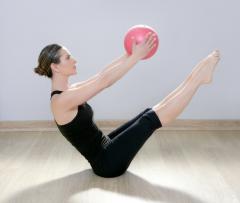Pilates
Certification Details
Breathing
Concentration
Pilates demands intense focus, the way that exercises are done is more important than the exercises themselves.
Control
"Contrology" was Joseph Pilates' preferred name for his method, and it was based on the idea of muscle control.All exercises are done with control, the muscles working to lift against gravity and the resistance of the springs and thereby control the movement of the body and the apparatus.
Centering
For practitioners to control their bodies, they must have a starting place: the center. The center is the focal point of the Pilates method. Many Pilates teachers refer to the group of muscles in the center of the body—encompassing the abdomen, lower and upper back, hips, buttocks, and inner thighs—as the "powerhouse". All movement in Pilates should begin from the center and move outward to the limbs.
Flow
Pilates aims for elegant economy of movement, creating flow through the use of appropriate transitions. Once precision has been achieved, the exercises are intended to flow within and into each other in order to build strength and stamina. In other words, the Pilates technique asserts that physical energy exerted from the center should coordinate movements of the extremities.
Postural alignment
Using correct posture while doing Pilates exercises improves safety by correcting muscle imbalances and optimizing coordination.
Precision
Precision is essential to correct Pilates. The focus is on doing one precise and perfect movement, rather than many halfhearted ones. Here Pilates reflects common physical culture wisdom, gaining more from a few energetic efforts than from many listless ones. The goal is for this precision to eventually become second nature and carry over into everyday life as grace and economy of movement.
Relaxation
Correct muscle firing patterns and improved mental concentration are enhanced with relaxation.
Stamina
With increased precision, motion becomes more efficient so there is less stress to perform the exercises.
Requirements
The following eligibility requirements have been implemented for the certification exam:
- You must be at least 18 years of age.
- You must hold adult CPR (cardiopulmonary resuscitation) certification and it must be current at the time of the exam. Those submitting proof of CPR with their application will be exempt from future CPR audits, up to the expiration date of the certification. (You may sit for the exam without proof of CPR; however, you will not receive your exam results until you provide proof of current CPR certification.)
- In order to take the Certification exams, you must attend the NAFTA workshop for the specific certification you are pursuing and have taken the practical examination component prior to receiving your on line access to the written exam.
Recertification
To get recertified in this certification you either need to earn 15 CEU's or take a new certification workshop. To apply for recertification, please log in to your account.



